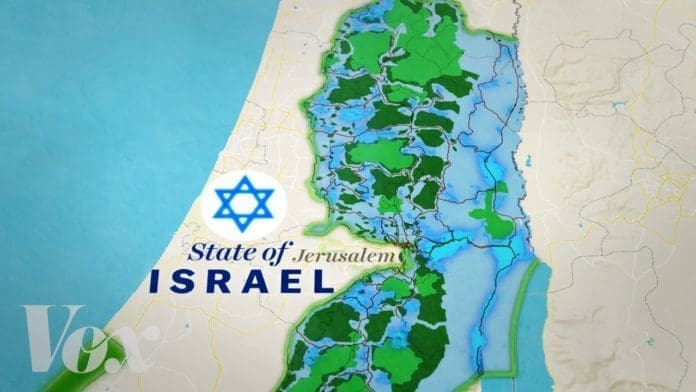Hundreds of thousands of Israelis filled the streets of Tel Aviv on Saturday night in what organizers hope will be one of the final mass rallies demanding the return of hostages held in Gaza, as a ceasefire deal brokered by US President Donald Trump enters its third day.
The Hostages and Missing Families Forum estimated that approximately 500,000 people attended the rally, transforming central Tel Aviv into a sea of yellow ribbons and photographs of captives who have spent months in Hamas custody.
The gathering came as Israel prepares for the expected release of hostages under the first phase of a ceasefire agreement that took effect on Friday. The mood was markedly different from previous rallies, mixing cautious optimism with lingering anxiety about whether the deal will hold.
President Trump announced Wednesday that both Israel and Hamas had signed off on the first phase of a peace plan following negotiations in the Egyptian Red Sea city of Sharm el-Sheikh. The announcement marked a significant diplomatic breakthrough after two years of devastating conflict.
Tal Shoham, who survived 505 days in captivity before being released in an earlier exchange, addressed the crowd. “In Gaza, I met fellow hostages who are still waiting to come home,” he said, his voice carrying across the packed square.
Ruby Chen, whose soldier son Itay Chen’s body is scheduled for return under the agreement, stood among the crowd, embodying the complex emotions many families face. For some, the deal brings hope of reunion. For others, it means receiving remains for proper burial.
The rally took place at Tel Aviv’s Hostages Square, which has become the symbolic heart of the campaign to bring captives home. What began as a small gathering of families has grown into a sustained movement that has drawn hundreds of thousands of Israelis to the streets week after week.
As Israelis gathered in Tel Aviv, large numbers of Palestinians were moving northward in Gaza under the ceasefire terms. The contrast between celebration in Israel and the return to devastated homes in Gaza captured the asymmetric nature of the conflict’s impact on both populations.
The diplomatic breakthrough came through intensive negotiations that Trump’s team conducted in Egypt. Egyptian President Abdel Fattah el-Sisi will co-chair a summit with Trump about Gaza in Sharm el-Sheikh on Monday afternoon that will host leaders from more than 20 countries, according to Egypt’s presidential spokesperson.
The summit aims to end the war in the Gaza Strip, enhance efforts to achieve peace and stability in the Middle East, and usher in a new era of regional security, the statement said. Trump is expected to travel to Israel before heading to Egypt for the ceremony.
The ceasefire represents the first sustained pause in fighting since the conflict began two years ago. Under the agreement’s first phase, Hamas is expected to release hostages in exchange for Palestinian prisoners, while humanitarian aid flows into Gaza increase significantly.
Gil Dickmann, whose cousin Carmel Gat was taken captive on October 7, 2023, and whose body was recovered almost a year later, described Saturday as one of his “happiest” days since learning of the truce. His sentiment reflected the complicated relief many families feel, knowing the deal comes too late for some.
The “Shirt Team,” volunteers who have been selling merchandise at Hostages Square to keep the campaign visible, found themselves preparing for what they hope will be the end of an era. For months, they’ve maintained a presence at the square, ensuring the faces of hostages remained in public consciousness.
Trump has indicated that Hamas will likely release all Israeli hostages by early next week, though skepticism remains about whether the militant group will fulfill all its commitments. Previous negotiations have collapsed, leaving families to endure false hopes and crushing disappointments.
The ceasefire emerged from Trump’s 20 point peace proposal, which differs from his earlier February 2025 plan. Trump had given Hamas a deadline of October 5 to accept the proposal or face consequences, a pressure tactic that appeared to contribute to the breakthrough.
For now, the massive crowd in Tel Aviv represented both celebration and cautious hope. Yellow balloons rose into the evening sky. Songs echoed through the streets. Families embraced while holding photographs of those still waiting to come home.
The rally’s size and energy reflected two years of sustained civic mobilization. What began as family vigils transformed into a national movement that pressured Israeli leadership to prioritize hostage recovery even as military operations continued.
As the crowd dispersed into the night, many carried the weight of knowing that while this rally brought hope, the coming days will determine whether that hope translates into actual reunions. The hostage families have learned through bitter experience that diplomatic announcements don’t always lead to open doors and returned loved ones.
Monday’s summit in Egypt could mark a historic turning point, or it could become another chapter in the long, painful saga of a conflict that has defined the region for decades. For the hundreds of thousands who filled Tel Aviv’s streets on Saturday, the answer to that question cannot come soon enough.
Source: newsghana.com.gh











